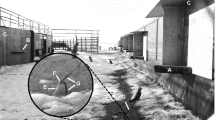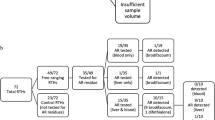Abstract
Anticoagulant rodenticides (ARs) are commonly used to control rodent pests. However, worldwide, their use is associated with secondary and tertiary poisoning of nontarget species, especially predatory and scavenging birds. No medical device can rapidly test for AR exposure of avian wildlife. Prothrombin time (PT) is a useful biomarker for AR exposure, and multiple commercially available point-of-care (POC) devices measure PT of humans, and domestic and companion mammals. We evaluated the potential of one commercially available POC device, the Coag-Sense® PT/INR Monitoring System, to rapidly detect AR exposure of living birds of prey. The Coag-Sense device delivered repeatable PT measurements on avian blood samples collected from four species of raptors trapped during migration (Intraclass Correlation Coefficient > 0.9; overall intra-sample variation CV: 5.7%). However, PT measurements reported by the Coag-Sense system from 81 ferruginous hawk (Buteo regalis) nestlings were not correlated to those measured by a one-stage laboratory avian PT assay (r = − 0.017, p = 0.88). Although precise, the lack of agreement in PT estimates from the Coag-Sense device and the laboratory assay indicates that this device is not suitable for detecting potential AR exposure of birds of prey. The lack of suitability may be related to the use of a mammalian reagent in the clotting reaction, suggesting that the device may perform better in testing mammalian wildlife


Similar content being viewed by others
Abbreviations
- AR:
-
Anticoagulant rodenticides
- PT:
-
Prothrombin time
- POC:
-
Point-of-care
- SGAR:
-
Second generation anticoagulant rodenticides
References
Abernathy EV, Hull JM, Fish AM, Briggs CW (2018) Secondary anticoagulant rodenticide exposure in migrating juvenile red-tailed hawks (Buteo jamaicensis) in relationship to body condition. J Raptor Res 52:225–230. https://doi.org/10.3356/JRR-17-39.1
Berlin N, Kelmer E, Segev G, Aroch I, Kelmer G (2019) Assessment of the CoaguChek-XS portable prothrombin time point-of-care analyzer for horses. J Vet Diagn Investig 31:448–452. https://doi.org/10.1177/1040638719832340
Berny P, Esther A, Jacob J, Prescott C (2018) Development of resistance to anticoagulant rodenticides in rodents. In: van den Brink N, Elliott JE, Shore RF, Rattner BA (eds) Anticoagulant rodenticides and wildlife. Springer, New York, pp 259–286
Bloom PH, Clark WS, Kidd JW (2007) Capture techniques. In: Bird D, Bildstein K (eds) Raptor research and management techniques. Hancock House Publishers Ltd, Surrey, BC, pp 193–219
Cox P, Smith RH (1992) Rodenticide ecotoxicology: pre-lethal effects of anticoagulants on rat behaviour. In: Borrecco JE, Marsh RE (eds) Proceedings of the 15th vertebrate pest conference. University of California, Davis, California, USA, pp 165–170
Dickson AJ (2020) Prevalence of anticoagulant rodenticides in ferruginous hawk nestlings and evaluation of a novel method to rapidly assess exposure. M.S. Thesis, Boise State University, Boise, Idaho, USA
Doerr JA, Wyatt RD, Hamilton PB (1975) Investigation and standardization of prothrombin times in chickens. Poult Sci 54:969–980. https://doi.org/10.3382/ps.0540969
Doolittle RF, Feng DF (1987) Reconstructing the evolution of vertebrate blood coagulation from a consideration of the amino acid sequences of clotting proteins. Cold Spring Harb Symp Quant Biol 52:869–874. https://doi.org/10.1101/SQB.1987.052.01.095
Elliott JE, Rattner BA, Shore RF, Van Den Brink NW (2016) Paying the pipers: mitigating the impact of anticoagulant rodenticides on predators and scavengers. Bioscience 66:401–407. https://doi.org/10.1093/biosci/biw028
Environmental Protection Agency (EPA) (2017) Restrictions on rodenticide products. https://www.epa.gov/rodenticides/restrictions-rodenticide-products. Accessed 3 Oct 2017
Erickson W, Urban D (2004) Potential risks of nine rodenticides to birds and nontarget mammals: a comparative approach. Office of Prevention, Pesticides and Toxic Substances, United States Environmental Protection Agency, Washington, DC, USA
Frost CL, Naudé RJ, Oelofsen W, Jacobson B (1999) Comparative blood coagulation studies in the ostrich. Immunopharmacology 45:75–81. https://doi.org/10.1016/S0162-3109(99)00058-2
Gamer M, Lemon J, Singh P (2019) irr: various coefficients of interrater reliability and agreement. R package version 0.84.1.https://CRAN.R-project.org/package=irr
Gossett DN (1993) Studies of ferruginous hawk biology: I. Recoveries of banded ferruginous hawks from presumed eastern and western subpopulations. II. Morphological and genetic differences of presumed subpopulations of ferruginous hawks. III. Sex determination of nestling ferruginous hawks. M.S. Thesis, Boise State University, Boise, Idaho, USA
Guddorf V, Kummerfeld N, Mischke R (2014) Methodical aspects of blood coagulation measurements in birds applying commercial reagents—a pilot study. Berliner und Münchener Tierärztliche Wochenschrift 127:322–327. https://doi.org/10.2376/0005-9366-127-322
Hadler MR, Buckle AP (1992) Forty-five years of anticoagulant rodenticides—past, present and future trends. In: Borrecco JE, Marsh RE (eds) Proceedings of the 15th vertebrate pest conference. University of California, Davis, California, USA, pp 165–170
Harris LF, Castro-López V, Killard AJ (2013) Coagulation monitoring devices: past, present, and future at the point of care. Trends Anal Chem 50:85–95. https://doi.org/10.1016/j.trac.2013.05.009
Herring G, Eagles-Smith CA, Bedrosian B, Craighead D, Domenech R, Langner HW, Parish CN, Shreading A, Welch A, Wolstenholme R (2018) Critically assessing the utility of portable lead analyzers for wildlife conservation. Wildl Soc Bull 42:284–294
Hindmarch S, Rattner BA, Elliott JE (2019) Use of blood clotting assays to assess potential anticoagulant rodenticide exposure and effects in free-ranging birds of prey. Sci Total Environ 657:1205–1216. https://doi.org/10.1016/j.scitotenv.2018.11.485
Hull B, Bloom P (2001) The North American banders manual for raptor banding techniques. North American Banding Council, Point Reyes Station
Jacob J, Buckle A (2018) Use of anticoagulant rodenticides in different applications around the world. In: van den Brink N, Elliott JE, Shore RF, Rattner BA (eds) Anticoagulant rodenticides and wildlife. Springer, New York, pp 11–44
Kazuki T, Manago K, Nakayama SMM, Moirta A, Ikenaka Y, Ishizuka M (2020) Pharmacokinetics/dynamics analysis of anticoagulant rodenticides with Egyptian fruit bats (Rousettus aegyptiacus). In: Proceedings of the international symposium on the chemistry hazards wildlife. February 5, 2020 Hokkaido University, Japan, pp 30–31
Kelmer E, Segev G, Codner C, Bruchim Y, Klainbart S, Aroch I (2014) Assessment of a portable prothrombin time analyzer (CoaguChek-XS) in dogs. J Vet Emerg Crit Care 24:455–460. https://doi.org/10.1111/vec.12200
Koo TK, Li MY (2016) A guideline of selecting and reporting intraclass correlation coefficients for reliability research. J Chiropractic Med 15:155–163. https://doi.org/10.1016/j.jcm.2016.02.012
Laakso S, Suomalainen K, Koivisto S (2010) Literature review on residues of anticoagulants in non-target animals. Nordic Council of Ministers, Copenhagen
Last JA (2002) The missing link: the story of Karl Paul Link. Toxicol Sci 66:4–6. https://doi.org/10.1093/toxsci/66.1.4
López-Perea JJ, Mateo R (2018) Secondary exposure to anticoagulant rodenticides and effects on predators. In: van den Brink N, Elliott JE, Shore RF, Rattner BA (eds) Anticoagulant rodenticides and wildlife. Springer, New York, pp 159–193
Martin AGR, Kirkpatrick WE, King DR, Robertson ID, Hood PJ, Sutherland JR (1994) Assessment of the potential toxicity of an anticoagulant, pindone (2-pivalyl-l, 3-indandione), to some Australian birds. Wildl Res 21:85–93. https://doi.org/10.1071/WR9940085
Monks DJ, Forbes NA (2007) Hematological. In: Bird D, Bildstein K (eds) Raptor research and management techniques. Hancock House Publishers Ltd, Surrey, BC, pp 270–284
Moritsch M (1985) Photographic guide for aging nestling ferruginous hawks. Bureau of Land Management, Boise
Murray M (2018) Ante-mortem and post-mortem signs of anticoagulant rodenticide toxicosis in birds of prey. In: van den Brink N, Elliott JE, Shore RF, Rattner BA (eds) Anticoagulant rodenticides and wildlife. Emerging topics in ecotoxicology (principles, approaches and perspectives). Springer, New York
Murray M, Tseng F (2008) Diagnosis and treatment of secondary anticoagulant rodenticide toxicosis in a red-tailed hawk (Buteo jamaicensis). J Avian Med Surg 22:41–46. https://doi.org/10.1647/2007-012R.1
Nabity MB, Harr KE, Camus MS, Flatland B, Vap LM (2018) ASVCP guidelines: allowable total error hematology. Vet Clin Pathol 47:9–21. https://doi.org/10.1111/vcp.12583
Nakayama SMM, Morita A, Ikenaka Y, Mizukawa H, Ishizuka M (2019) A review: poisoning by anticoagulant rodenticides in non-target animals globally. J Vet Med Sci 81:298–313. https://doi.org/10.1292/jvms.17-0717
Newbould A, Norman E (2013) Comparison of point-of-care analysis using Coaguchek XS and standard laboratory-measured prothrombin time in dogs. N Z Vet J 61:18–24. https://doi.org/10.1080/00480169.2012.709816
Pelz H-J, Rost S, Hünerberg M, Fregin A, Heiberg A-C, Baert K, MacNicoll AD, Prescott CV, Walker A-S, Oldenburg J, Müller CR (2005) The genetic basis of resistance to anticoagulants in rodents. Genetics 170:1839–1847. https://doi.org/10.1534/genetics.104.040360
Pirmohamed M (2006) Warfarin: almost 60 years old and still causing problems. Br J Clin Pharmacol 62:509–511. https://doi.org/10.1111/j.1365-2125.2006.02806.x
Plesch W, Wolf T, Breitenbeck N, Dikkeschei LD, Cervero A, Perez PL, van den Besselaar AMHP (2008) Results of the performance verification of the CoaguChek XS system. Thromb Res 123:381–389. https://doi.org/10.1016/j.thromres.2008.04.021
Rattner BA, Horak KE, Johnston JJ (2010) Comparative toxicity of diphacinone to northern bobwhite (Colinus virginianus) and American kestrels (Falco sparverius). Ecotoxicol Environ Saf 73:1159–1164. https://doi.org/10.1016/j.ecoenv.2010.05.021
Rattner BA, Horak KE, Lazarus RS, Goldade DA, Johnston JJ (2014) Toxicokinetics and coagulopathy threshold of the rodenticide diphacinone in eastern screech-owls (Megascops asio). Environ Toxicol Chem 33:74–81. https://doi.org/10.1002/etc.2390
Review Memorandum (2018) Substantial equivalence determination decision summary. http://www.accessdata.fda.gov/cdrh_docs/reviews/K093243.pdf> Accessed 17 Oct 2019
Rodriguez-Ramos J (2009) Lead in griffon and cinereous vultures in central Spain: Correlations between clinical signs and blood lead levels. In: Watson RT, Fuller M, Pokras M, Hunt WG (eds) Ingestion of lead from spent ammunition: implications for wildlife and humans. The Peregrine Fund, Boise
R Core Team (2018) R: a language and environment for statistical computing. R Foundation for Statistical Computing, Vienna, Austria. https://www.R-project.org/
van den Brink N, Elliott JE, Shore RF, Rattner BA (2018) Anticoagulant rodenticides and wildlife. Springer, New York
Webster K, Harr K, Bennett D, Williams T, Cheng K, Maisonneuve F, Elliott J (2015) Assessment of toxicity and coagulopathy of brodifacoum in Japanese quail and testing in wild owls. Ecotoxicology 24:1087–1101. https://doi.org/10.1007/s10646-015-1449-1
Wells PS, Brown A, Jaffey J, McGahan L, Poon M-C, Cimon K (2007) Safety and effectiveness of point-of-care monitoring devices in patients on oral anticoagulant therapy: a meta-analysis. Open Med 1:131–146
Acknowledgements
The authors thank Dr. M. Brooks and A. Stablein from the Comparative Coagulation Laboratory in the Animal Health Diagnostic Center at Cornell University for assistance with prothrombin time analyses; G. Isted, B. Walker, P. Dumandan, S. Alsup, T. Jolley, J. Yurick, P. Ortiz, M. Sherman, and A. Meyer for field assistance and sample processing; and G. Herring and two anonymous reviewers for comments that improved our manuscript. Any use of trade, firm, or product names is for descriptive purposes only and does not imply endorsement by the U.S. Government. The findings and conclusions in this article are those of the author(s) and do not necessarily represent the views of the U.S. Fish and Wildlife Service.
Funding
This work was supported by the United States Fish and Wildlife Service [Cooperative Agreement Award F16AC00961], the Raptor Research Center at Boise State University and the US Geological Survey.
Author information
Authors and Affiliations
Contributions
BWS, JRB, and TEK obtained funding; AJD, JRB, TEK, BWS, KAM, and BAR designed the study; AJD collected data with assistance of MJS, ZPW, and MJL; AJD and JRB analyzed the data and interpreted them with assistance from TEK and BAR, AJD led writing with assistance from JRB and TEK and all authors contributed to revisions.
Corresponding author
Ethics declarations
Conflict of interest
The authors declare no conflicts of interest.
Ethical Approval
These studies were approved by the Boise State University Animal Care and Use Committee (protocols #006-AC18-003 and #AC17-015) and conducted under the following State and Federal permits: Colorado scientific collection license #19trb2091a, state of Idaho permits #110728 and #990121, Wyoming Chapter 33 permit #729, and USGS Bird Banding Permits #23715 and #22929. All study animals were released unharmed at original capture locations.
Availability of Data and Material
Data from this study can be found in: Dickson A (2020) Prevalence of Anticoagulant Rodenticides in Ferruginous Hawk Nestlings and Evaluation of a Novel Method to Rapidly Assess Exposure. MS thesis, Boise State University, Boise, Idaho, U.S.A.
Electronic supplementary material
Below is the link to the electronic supplementary material.
Rights and permissions
About this article
Cite this article
Dickson, A.J., Belthoff, J.R., Mitchell, K.A. et al. Evaluating a Rapid Field Assessment System for Anticoagulant Rodenticide Exposure of Raptors. Arch Environ Contam Toxicol 79, 454–460 (2020). https://doi.org/10.1007/s00244-020-00763-6
Received:
Accepted:
Published:
Issue Date:
DOI: https://doi.org/10.1007/s00244-020-00763-6




